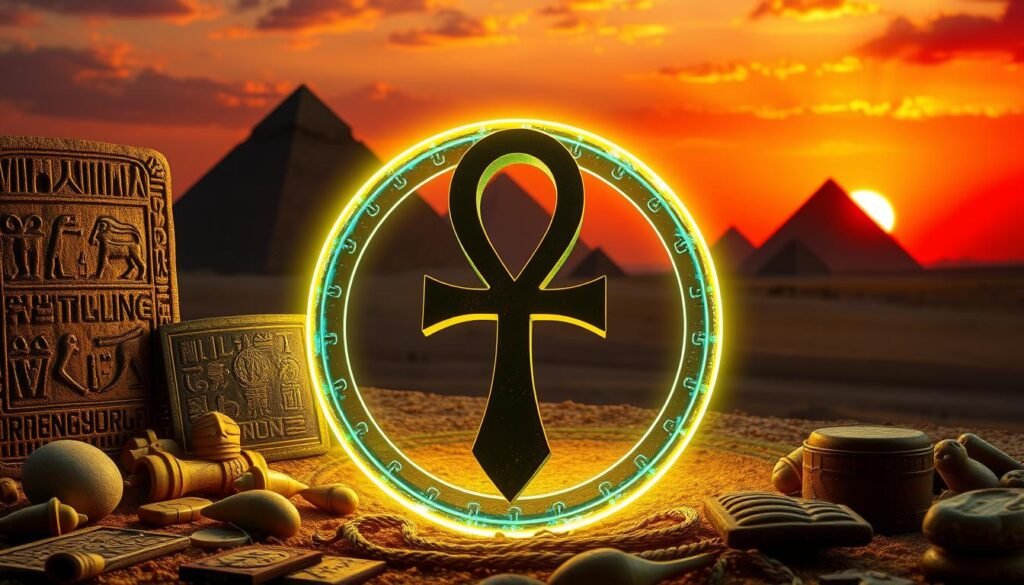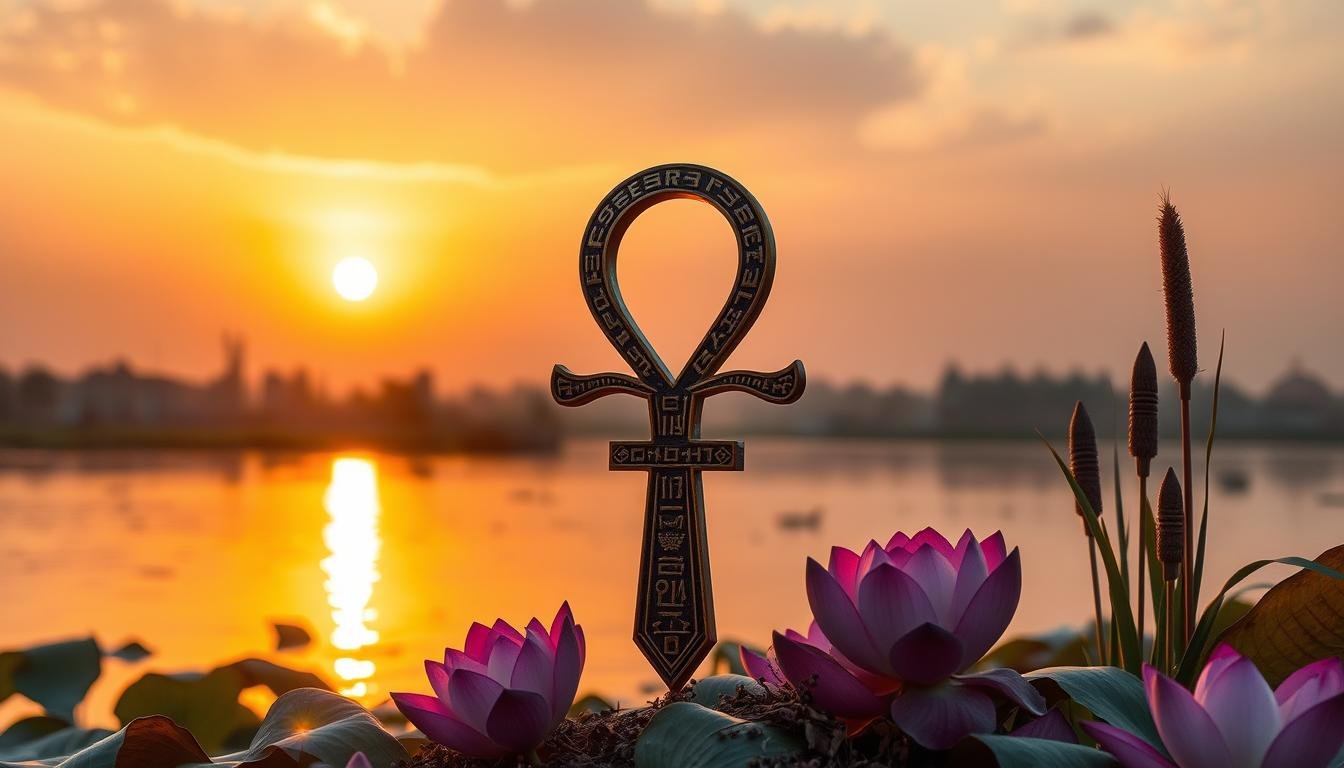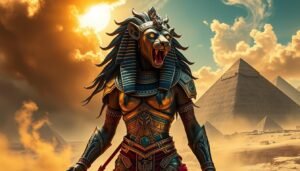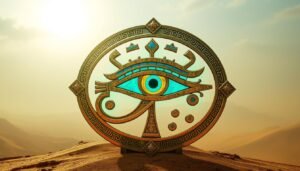Ever wondered about the ankh, the ancient Egyptian symbol of life? It’s a cross with a loop that has amazed people for thousands of years. It shows the power of life and the hope for eternal life1.
The ankh started around 3000 BC in ancient Egypt. It was used a lot in hieroglyphics and art1. It goes back to the Early Dynastic period (3150 BC – 2613 BC)2.
Exploring Egyptian culture and spirituality, you’ll find the ankh is a key symbol. It means eternal life and was used by gods to give life1. It’s also called ‘the key of life’ or ‘the cross of life.’
The ankh’s meaning is deep in Egyptian mythology1. It was found in places like Persia and Mesopotamia in digs2.
Key Takeaways:
- The ankh is an ancient Egyptian symbol representing life and eternity.
- It originated around 3000 BC and was widely used in hieroglyphics and art.
- The ankh was associated with Egyptian deities and used to bestow life.
- Its influence extended beyond Egypt to other ancient civilizations.
- The ankh continues to hold spiritual significance in modern times.
Origins and Meaning of the Ankh
The ankh is an ancient Egyptian symbol that has fascinated people for thousands of years. It looks like a cross with a loop at the top. It was first seen in the Early Dynastic Period (c. 3150 – 2613 BCE)3.
This symbol was very important in ancient Egypt. It was especially loved during the times of Hatshepsut, Akhenaten, Tutankhamun, and Ramesses II34.

The Ankh as a Symbol of Eternal Life
The ankh is linked to eternal life in ancient Egyptian beliefs. It means life, the afterlife, fertility, and eternal existence3. It was tied to the gods and goddesses, especially Isis and Osiris3.
Isis is often shown with the ankh. This shows her role as the goddess of life and magic3.
The ankh was found in tombs, paintings, and inscriptions in ancient Egypt3. It was believed to keep life going and revive souls in the afterlife. This made it very important in funerals.
Theories on the Ankh’s Physical Representation
Despite being everywhere in ancient Egyptian art, what the ankh originally looked like is still debated. Scholars have many theories about its origins and meaning.
One idea is that the ankh started as a sandal strap. This links it to walking, progress, and life’s journey3.
Others think the ankh is a knot made of cloth or reeds. This shows its connection to binding and balance between life and death, or heaven and earth.
Some believe the ankh is a mix of male and female symbols. This fits with its link to fertility and new life.
The ankh’s lasting presence in ancient Egyptian culture shows its timeless appeal. It speaks to our universal quest to understand life and death.
Exploring the ankh’s origins and meaning reveals a symbol that goes beyond time and culture. It invites us to think about the nature of existence and the cycle of life.
The Ankh in Ancient Egyptian Religion
In ancient Egypt, the ankh symbol was very important. It stood for life, fertility, and the gods’ power. The ankh was seen in many places, showing the life force in the world5.

Association with the Gods and Divine Power
The ankh was linked to the gods and goddesses. Gods were often shown with ankh signs, showing their power over life and death6. They used the ankh to bless pharaohs and people, giving them life and wealth.
Pharaohs, seen as gods’ representatives, carried the ankh too. This showed their connection to the divine5.
In the New Kingdom (1570-1069 BCE), the ankh was closely tied to Amun, the top god. It was used in Amun’s temple ceremonies, showing its royal and divine sides7. The ankh’s importance grew with Isis and Osiris, two key gods7.
The Ankh as a Symbol of Life Force
In Egypt, life was seen as a sacred force. The ankh symbolized this life force. It stood for both life and death, showing the balance in Egyptian thought7.
The gods used the ankh to bring people back to life after death. This ensured eternal life in the afterlife.
The ankh was also linked to rebirth and resurrection. In art and hieroglyphs, it showed renewal and new life. It was given to the dead, promising them life in the afterlife6.
The ankh’s meaning went beyond religion. It was used in medicine for healing and health5. It was also in amulets and jewelry, believed to offer magical protection and benefits75.
Depictions of the Ankh in Art and Hieroglyphs
The ankh was a symbol of life in ancient Egypt. It was seen in art and hieroglyphs. It showed life or things that give life like air or water8.
This symbol was in wall paintings and jewelry. It made living a real thing8.
In hieroglyphs, the ankh was important. It stood for the sounds Ꜥ-n-ḫ. This sound is in words like “life.”
It was also in words for “mirror” and “floral bouquet.” This shows its deep link to life.
One amazing picture shows gods giving the ankh to the king. This means the gods were giving him life. This helps us understand the ankh’s big role in ancient Egypt.
The ankh was more than just life and power. It could even mean water in some art.
The ankh was everywhere in ancient Egypt. It shows its big role in culture. As you learn about Egyptian symbols, the ankh is a symbol that still fascinates us today.
| Ankh Depiction | Meaning |
|---|---|
| Physical object | Representing life or life-giving substances |
| Hieroglyphic sign | Representing the consonants Ꜥ-n-ḫ (life) |
| Held by gods to the king’s nose | Offering the breath of life |
| Replacing water zigzag lines | In scenes of ritual purification |
The ankh is from the Early Dynastic Period, around 3100–2900 B.C. It’s made of greywacke. It’s 14.5 wide, 3.5 deep, and 17.6 long9. It’s a key piece in Egyptian art and hieroglyphs. It invites us to explore its deep meanings.
The Ankh as a Decorative Motif
The ankh symbol was more than just a spiritual sign. It was everywhere in ancient Egyptian art and buildings. Its unique shape made it perfect for decorating many things, from jewelry to temple walls10. Exploring ancient Egyptian art, you’ll see the ankh everywhere. It shows its big role in both spiritual and daily life.
Ankh-Shaped Objects and Artifacts
The ankh was used in many objects and items11. You could find mirrors, flower bouquets, and even musical instruments shaped like the ankh. These items showed the ancient Egyptians’ creativity and their love for the ankh7. They were both useful and held deep meaning, reminding people of life’s importance.
The Ankh in Temple Decorations
In ancient Egyptian temples, the ankh was a big part of the decorations. The walls and shrines were filled with reliefs and paintings featuring the ankh11. Along with other symbols, the ankh stood for life, power, and stability. These were key to a good and lasting society711.
The ankh’s role in art and architecture shows its big impact on ancient Egypt. It was seen in many places, from small amulets to big temples10. As you learn more about Egyptology, the ankh’s lasting influence will remind you of its importance in ancient life.
The Ankh and the Concept of the Afterlife
The ancient Egyptians believed deeply in the afterlife. The Ankh symbol was key in this belief. It was used in funerals to help souls reach the afterlife12.
This symbol was all about eternal life. It showed that life goes on even after we die.
The Ankh in Tomb Paintings and Reliefs
In ancient Egyptian art, the Ankh was everywhere. It showed hope for eternal life. The Ankh was very important for the soul’s journey after death13.
The Egyptians thought the afterlife was like life on earth. The Ankh connected the living and the dead13.
The Ankh was shown in scenes with Isis and Anubis. They used it to bring the soul back to life in the afterlife13. This showed the Ankh’s role in moving from life to eternal life.
| Tomb | Dynasty | Ankh Depictions |
|---|---|---|
| Tomb of Nefertari | 19th Dynasty | Numerous Ankh symbols adorn the walls, representing the queen’s journey to the afterlife |
| Tomb of Seti I | 19th Dynasty | Ankh symbols appear in various scenes, including the king’s journey through the underworld |
| Tomb of Tutankhamun | 18th Dynasty | Ankh-shaped mirror and other artifacts found, symbolizing the king’s eternal life |
The Ankh in these places showed it was key for immortality. It helped ensure safe passage to the afterlife. The Ankh’s lasting role in tomb art shows its deep importance in ancient Egypt.
The Ankh as a Symbol of Power and Authority
In ancient Egypt, the Ankh was more than just a symbol of life. It showed power and authority too. Pharaohs, seen as gods on earth, held the Ankh. This showed they controlled life and death14.
The Ankh was key in the pharaohs’ regalia. It was on their crowns and scepters14. This showed their divine leadership and connection to the gods14.
The Ankh reminded everyone of the pharaoh’s power. It showed they could give life and blessings14.
In art, gods and goddesses held the Ankh too. This meant they could give life and protection to pharaohs and people14. It made the pharaohs seem chosen by the gods14.
“The Ankh, the Djed, and the Was scepter were the most powerful symbols of authority and divine power in ancient Egypt, often combined to represent the pharaoh’s dominion over life, stability, and control.”
The Ankh was linked with symbols like the Was scepter and the Djed pillar. These showed control and stability. Sometimes, gods like Ptah held these symbols, showing their power.
The Ankh started around 4000 BC5. It was seen in many artifacts and art5. Pharaohs carried it to show their power, a tradition that lasted5.
In summary, the Ankh was more than a symbol of life. It showed power and authority in ancient Egypt. Its link with pharaohs and gods made it key in ancient Egyptian iconography.
The Ankh in Amulets and Jewelry
In ancient Egypt, the ankh was a symbol of life and protection. It was often used in amulets and jewelry. These items were thought to give the wearer life-giving energy and divine protection.
By wearing ankh amulets, ancient Egyptians wanted to stay safe and healthy. They believed it helped them in this life and the afterlife.
Ankh Amulets as Protective Talismans
The ancient Egyptians thought amulets shaped like hieroglyphics could give the wearer special powers. Ankh amulets were worn daily and placed in tombs. They were made from gold, silver, and precious stones, each with its own meaning.
Today, you can find many ankh amulets and jewelry. Prices range from $142.97 to $199.97 for sterling silver pendants. There are also more elaborate designs like the Solid Yellow Gold Triple Goddess Ankh Hook Earrings with Gemstone, starting at $850.0015.
Other beautiful pieces include the Solid Gold Ankh Post Dangling Earrings with Gemstone at $450.00. The Triquetra and Ankh Solid Yellow Gold Earrings start from $390.0015.
The Rarity of Ankh-Shaped Amulets
Ankh-shaped amulets were rare in ancient Egypt. They first appeared in the Old Kingdom (c. 2700 to 2200 BC). This makes authentic ankh amulets very valuable.
For a more affordable option, the cross of life Sterling Silver Ankh Hoop Earrings with Gemstone are priced at $72.9715. If you want luxury, the Celtic Ankh 14K Solid Gold Pendant with Gem is $800.00. The Large Ankh Solid Gold Earrings are also $800.0015.
| Ankh Jewelry | Material | Price Range |
|---|---|---|
| Ankh sterling silver pendant | Sterling Silver | $142.97 – $199.97 |
| Solid Yellow Gold Triple Goddess Ankh Hook Earrings with Gemstone | 14K Solid Gold, Gemstone | Starts from $850.00 |
| Solid Gold Ankh Post Dangling Earrings with Gemstone | 14K Solid Gold, Gemstone | $450.00 |
| Triquetra and Ankh Solid Yellow Gold Earrings | 14K Solid Gold | Starts from $390.00 |
| The cross of life Sterling Silver Ankh Hoop Earrings with Gemstone | Sterling Silver, Gemstone | $72.97 |
| Celtic Ankh 14K Solid Gold Pendant with Gem | 14K Solid Gold, Gemstone | $800.00 |
For a unique piece, look at the ankh amulet inspired by the British Museum. It has a lapis lazuli stone, as valuable as gold in ancient Egypt16. It’s 43cm long, 3cm high, and 2cm wide. It weighs 0.50 kg and is a stunning piece of ancient Egyptian history16.
Exploring ankh amulets and jewelry, remember each piece holds ancient Egyptian history and symbolism. They remind us of our quest for protection, well-being, and eternal life.
The Ankh in Modern Times
The ancient Egyptian ankh symbol is still loved today. It has been around for over 5,000 years17. Now, it’s a big part of modern art and fashion. It stands for life, the sun, fertility, and forever life18.
The Ankh as a Popular Design Element
The ankh is everywhere in art and fashion18. Famous musicians like Erykah Badu and Tupac Shakur have worn it. This shows it’s big in music too18.
It’s used in many things, pleasing many people. This makes it a favorite in design.
The Ankh in Contemporary Art and Pop Culture
The ankh is also in modern art and pop culture. In the 1960s, it was part of the Hippie movement. It stood for peace and love18.
It’s also loved by people of African descent in the West. They see it as a symbol of their African roots18.
In the USA, the 1970s saw Kemetic spirituality start. It uses the ankh as a key symbol. This shows the ankh’s deep meaning in some groups18.
The ankh keeps inspiring people with its deep meaning. It connects us to ancient Egypt’s culture. It will keep being important in art, fashion, and pop culture for a long time.
Studying Egyptology and the Ankh
Egyptology is the study of ancient Egypt. It’s a favorite subject at many universities5. The ankh, a symbol from the Early Dynastic Period (c. 3150-2613 BCE)19, is key in ancient Egyptian symbols19. It shows life, eternal existence, and life’s creative power19.
Some might worry about too much history homework in Egyptology. But, there are many resources to help. Sites like Papersowl offer homework help in History and Egyptology5.
The ankh started in ancient Egypt around 4000 BC5. It has lasted through the ages19.
Exploring Egyptology, you’ll learn about the ankh’s role in ancient culture. It’s linked to fertility, protection, and healing5. The ankh still matters today, in spiritual practices and creativity19.
Studying Egyptology lets you dive into the ankh’s meaning and lasting impact. You can wear it, keep it as a charm, or use it in meditation19. This way, you’ll get to know the ancient civilization that created it better.
| Resources for Studying Egyptology | Benefits |
|---|---|
| University Courses | In-depth learning from expert faculty |
| Online Platforms (e.g., Papersowl) | Homework assistance and support |
| Museums and Exhibitions | Firsthand experience with artifacts and art |
| Books and Academic Journals | Comprehensive knowledge and latest research |
By studying Egyptology and the ankh, you’ll learn a lot about ancient Egypt. You’ll see how it affects us today. With the right tools and passion, exploring the ankh’s meaning is very rewarding.
The Versatility and Timelessness of the Ankh Symbol
The Ankh symbol is from ancient Egypt. It means life and never-ending life20. It has been loved for a long time and is still popular today21.
The Ankh is loved in fashion and jewelry. Celebrities and influencers have made it even more popular20. A sterling silver Ankh ring is a great accessory for any day or special event22.
Ankh silver pendants are versatile. They fit both casual and formal styles21.
The Ankh symbolizes a connection to the legacy of ancient Egypt, a civilization renowned for its achievements in art, architecture, and religion22.
The Ankh is in many parts of today’s culture, like:
- Tattoos and body art, showing a link to old wisdom and spirit20
- Spiritual and New Age practices, meaning life, fertility, and forever20
- Album covers, music videos, and live shows in many styles20
Designers and jewelry makers are using the Ankh in their work. This shows a trend to connect with old wisdom and culture21. The Ankh’s simple yet elegant design makes it appealing for those wanting style and meaning21.
The Ankh stands for strength, resilience, and life itself22. Giving a sterling silver Ankh ring or pendant is a special gift. It means life, forever, and protection22.
Wearing the Ankh is more than just fashion. It’s about connecting with a symbol that holds deep meaning in history, spirit, and personal power22. The Ankh has made a big impact in today’s pop culture and society. It shows its lasting power and importance20.
Conclusion
The ankh symbol has been loved for thousands of years23. It shows the deep impact of ancient Egypt on us today24. This symbol means life and connects us to the past24.
The ankh started in ancient Egypt around 3100 BCE23. It was key in their religion and daily life23. It was linked to gods like Anubis and Isis, showing its power2524.
Now, the ankh is important worldwide24. It’s seen in fashion, art, and movies23. People wear ankh jewelry to show their connection to this symbol23.
The ankh’s lasting appeal shows its power and timelessness23. It reminds us of the eternal cycle of life23. Exploring Egypt’s history, the ankh is a powerful symbol of our shared journey.
FAQ
What is the ankh, and what does it symbolize?
The ankh is an ancient Egyptian symbol for “life”. It looks like a cross with a loop at the top. This symbol means eternal life.
It was very important in ancient Egyptian religion and culture.
What are the origins of the ankh symbol?
The ankh started around 4000 BC in ancient Egypt. It was linked to the goddess Isis and meant life and fertility.
There are many theories about what it originally looked like. It might have been a knot, a sign of heaven and earth, or a symbol of male and female.
How was the ankh used in ancient Egyptian religion?
The ankh gave life in ancient Egypt. Gods held it to bless pharaohs and people.
It was the life force that moved through the world. Gods used it to bring people back to life after death.
How was the ankh depicted in ancient Egyptian art and hieroglyphs?
In art, the ankh was a symbol of life. It was also used in hieroglyphs to mean “life”.
Gods gave the ankh to kings to give them life. It was also used in rituals to purify water.
How was the ankh used as a decorative motif in ancient Egypt?
The ankh was used more than any other symbol in decoration. It was on mirrors, bouquets, and other objects.
It was also on temple walls and shrines. It meant life, power, and stability.
What is the connection between the ankh and the afterlife in ancient Egyptian belief?
The ankh was key to the afterlife in ancient Egypt. People believed in eternal life after death.
The ankh was in tomb paintings to show hope for eternal life. Ankhs were placed in sarcophagi for life after death.
How was the ankh used as a symbol of power and authority in ancient Egypt?
The ankh showed power and authority in ancient Egypt. Pharaohs held it, and it was on their crowns and scepters.
It was linked to the was-sceptre and djed pillar. These symbols meant power and stability.
How was the ankh used in amulets and jewelry in ancient Egypt?
The ankh was for protection and luck in ancient Egypt. It was in amulets and jewelry with magical powers.
People wore ankh-shaped amulets for protection. They were rare but appeared in the Old Kingdom.
What is the significance of the ankh in modern times?
The ankh is still important today. It means life, fertility, protection, and the afterlife.
It’s in jewelry and modern art. It’s also part of African culture, Neopaganism, and the goth subculture.
How can students manage the study of Egyptology and the ankh?
Egyptology is studied at many universities. It’s a big subject, but there’s help available.
Platforms like Papersowl offer homework help in History and Egyptology. This makes studying Egyptology easier for those interested.
Source Links
- Ankh Meaning: Symbolism & Historical Context – https://www.vaia.com/en-us/explanations/religious-studies/religious-symbols-and-art/ankh-meaning/
- Ankh – Ancient Egyptian Hieroglyphic Ideograph | Mythology.net – https://mythology.net/egyptian/egyptian-concepts/ankh/
- Egyptian Ankh Symbol – https://egyptunitedtours.com/ankh-symbol/
- Ankh – New World Encyclopedia – https://www.newworldencyclopedia.org/entry/Ankh
- Egyptian Symbol of Life – https://www.luxorandaswan.com/blog/egyptian-history/egyptian-symbol-of-life
- The Ankh of African Tradition – VOICE – https://theievoice.com/the-ankh-of-african-tradition/
- The Ankh – https://www.worldhistory.org/Ankh/
- Ancient Egyptian Hieroglyphics – Ankh, Scarab and Wedjat Eye – https://www.artyfactory.com/egyptian_art/egyptian_hieroglyphs/ankh-scarab-wedjat.htm
- Libation Dish Depicting Ka-Arms Presenting an Ankh-Sign | Early Dynastic Period | The Metropolitan Museum of Art – https://www.metmuseum.org/art/collection/search/543866
- Ankh symbol – (Ancient Portraiture and Biography) – Vocab, Definition, Explanations | Fiveable – https://library.fiveable.me/key-terms/ancient-portraiture-and-biography/ankh-symbol
- Ankh | Ancient Egypt Online – https://ancientegyptonline.co.uk/ankh/
- NomadGalleryBlog – https://nomadgallery.net/blog/2023/08/08/the-ankh-symbol-the-key-to-life-and-immortality-in-ancient-egypt/?srsltid=AfmBOoqs81nYgW0nW9jgZEP7GF0giGi78-1T3zKiwqxZwcz3WdeIGZht
- The Ancient Egyptian Ankh (Key of Life) – https://www.swanbazaar.com/Blog/post/key-of-life
- Unlocking The Ankh Meaning: Symbolism, Significance, And Interpretations | EZ TOUR EGYPT – https://eztouregypt.com/ankh-meaning/
- Ankh Jewelry Store – https://www.peterstone.com/collections/ankh-jewelry-store?srsltid=AfmBOoo-9VSDmK3R_iqaVffpn15TntH-nPTU9ycRlqImAYnS35zn17Ba
- Egyptian Ankh Bronze Necklace – https://www.britishmuseumshoponline.org/ankh-bronze-necklace.html
- The Egyptian Ankh Decoded: Meaning & Reasons to Wear – the Conscious Vibe – https://theconsciousvibe.com/what-does-the-ancient-egyptian-ankh-symbolize-origin-meaning/
- The Ankh Symbol: Origins and Significance in Modern Day Spirituality – Conscious Vibes Art & Design – https://consciousvibesart.com/blog/the-ankh-symbol-origins-and-significance-in-modern-day-spirituality/
- The College of Psychic Studies : Enlighten : The ultimate meaning of the ancient egyptian ankh – https://www.collegeofpsychicstudies.co.uk/enlighten/the-ultimate-meaning-of-the-ancient-egyptian-ankh/
- How is the Ankh symbol used in modern culture? – https://symbolismhub.com/how-is-the-ankh-symbol-used-in-modern-culture/
- The Emergence of the Symbol of the Cross – https://oureternal.love/blog/the-emergence-of-the-symbol-of-the-cross/
- Why Wear the Ankh Cross? – https://oureternal.love/blog/why-wear-the-ankh-cross/
- ANKH – ANKH – https://www.ankh.co.uk/
- Embracing The Timeless Wisdom Of The Ankh: A Journey Through Ancient Egyptian Symbolism | EZ TOUR EGYPT – https://eztouregypt.com/ankh/
- The Meaning Of The Ankh: The Egyptian Key Of Life – https://medium.com/@dahliasaadedin/the-meaning-of-the-ankh-the-egyptian-key-of-life-392ebe68f08e




